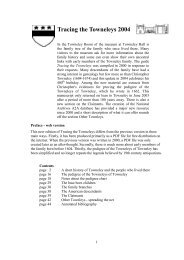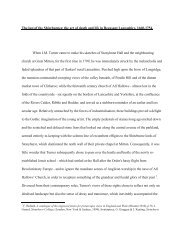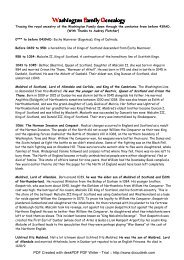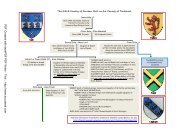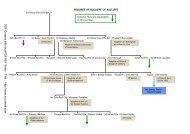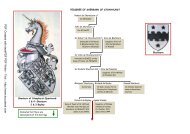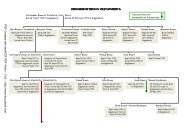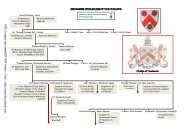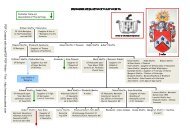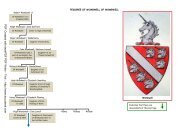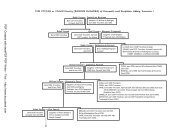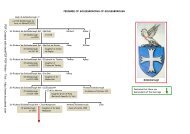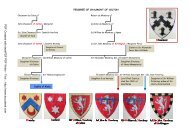WASHINGTON Family Genealogy.pdf - Ingilby History
WASHINGTON Family Genealogy.pdf - Ingilby History
WASHINGTON Family Genealogy.pdf - Ingilby History
Create successful ePaper yourself
Turn your PDF publications into a flip-book with our unique Google optimized e-Paper software.
Washington ashington ashington <strong>Family</strong> amily <strong>Genealogy</strong> enealogy<br />
Tracing the royal ancestry of the Washington <strong>Family</strong> down through the centuries from before 439AD.<br />
(With Thanks to Audrey Fletcher)<br />
0*** to before 0439AD: Eochy Munrevar (Eugenius), King of Dalrieda.<br />
Before 0439 to 958: a hereditary line of Kings of Scotland descended from Eochy Munrevar.<br />
958 to 1034: Malcolm II, King of Scotland. A continuation of the hereditary line of Scottish Kings.<br />
1043 to 1045: Bethoc (Beatrix), Queen of Scotland. Daughter of Malcolm II, she was born in Angus in<br />
984 and married Crinan the Thane, “Mormaer of Atholl”. He was born in 975 and died in battle in 1045 in<br />
Dunkeld, Scotland. He was the Abbott of Dunkeld. Their eldest son, King Duncan of Scotland, died<br />
unmarried c1043.<br />
Maldred of Scotland, Lord of Allendale and Carlisle, and King of the Cumbrians. The Washington Line<br />
is descended from this Maldred. He was the younger son of Beatrix, Queen of Scotland and Crinan the<br />
Thane. Born in 1009 or 1015 at Dunbar he was slain in battle in 1045 alongside his father. He married<br />
Aeglithia (Ealdgyth) of Northumbria sometime between 1030 and 1038. She was also known as Edith of<br />
Northumberland, and was the grand-daughter of Lady Godiva of Mercia. Her father was Ughtred of<br />
Northumberland and her grandfather was King Ethelred II. Maldred’s eldest brother became Duncan I,<br />
King of Scotland and was killed by Macbeth. Macbeth was succeeded by Duncan’s two sons: Malcolm III,<br />
King of Scotland, and Donald III, King of Scotland. Their story was immortalised by Shakespeare.<br />
1066: The Norman Invasion and Conquest. Radical changes occurred in England and Scotland as a result<br />
of the Norman Invasion. The people of the North did not accept William the Conqueror as their new King<br />
and the opposing forces clashed at the Battle of Shaden’s Hill in 1068, on the northern boundary of<br />
Washington, Tyne and Wear. William the Conqueror won, his weapons were better than ours. The Danes and<br />
the Scots helped us fight the battle so we didn’t stand alone. Some of the fighting was on the Black Fell,<br />
but the main fighting was on Shadens Hill. Those survivors who weren’t able to flee were slaughtered, whole<br />
families of them. Widespread famine followed and corpses rotted where they fell, there was no-one left to<br />
bury them. The North of England became virtually uninhabited as people were either slaughtered, fled or<br />
died of famine. This state of affairs lasted for nine years. Had William had the Doomsday Book compiled a<br />
few years earlier than he did then the pages for the North of England would have been left completely<br />
blank.<br />
Maldred, Lord of Allendale. Born around 1039, he was the elder son of Maldred of Scotland and Edith<br />
of Northumberland. He received Winlaton from the Bishop of Durham in 1084. His younger brother,<br />
Gospatrick, who was born about 1040, bought the Earldom of Northumbria from William the Conqueror. The<br />
cost was high; the betrayal of his cousin, Malcolm III King of Scotland, and his Scottish ancestry. This is<br />
the story of the betrayal: Malcolm III King of Scotland was using Cumberland and Westmoreland as a base<br />
for raids against William the Conqueror in 1070. To prove his loyalty to William the Conqueror, Gospatrick<br />
plundered Cumberland and slaughtered the inhabitants. He then returned with his plunder to his fortress<br />
at Bamburgh Castle. Malcolm took his revenge, not against his cousin Gospatrick but against the people of<br />
Northern England! He was no better than William the Conqueror, he slaughtered what few inhabitants were<br />
left or took them as slaves. This incident became known as “King Malcolm’s Revenge”. That Gospatrick was<br />
created the First Earl of Dunbar (whose Coat of Arms is Gules a Lion Rampant Argent) by his cousin King<br />
Malcolm of Scotland leads to the speculation that they were perhaps playing “War Games” at the cost of<br />
the Northern English.<br />
Uchtred fitz Maldred. Not a lot is known about Uchtred fitz Maldred. He was the son of Maldred, Lord<br />
of Allendale and married Athelreda, born in Dunbar yet reputed to be an English Princess. He died in<br />
1128/9.<br />
PDF Created with deskPDF PDF Writer - Trial :: http://www.docudesk.com
Dolfin fitz Uchtred, Lord Raby. Not a lot is known about Dolfin fitz Uchtred. He was the son of<br />
Uchtred fitz Maldred and married Adilicia (Alice) of Durham, whose father is said to have been Walcher,<br />
Bishop of Durham who was burnt to death in 1080 when a mob set alight a church he was in. Dolfin fitz<br />
Uchtred was appointed Lord of Raby in 1131 and died in 1136. The “Dolfin” part of his name is a reference<br />
to “the House of Dunbar”.<br />
Sir Patrick fitz Dolfin Raby. Born before 1136 at Hertburn, he was a younger son of Dolfin fitz<br />
Uchtred. He died around 1190. Upon his marriage to Cecily de Offerton he became known as Sir Patrick de<br />
Offerton and Hirsel. The lands of Offerton stand across the River Wear from Washington. He also had<br />
estates in Scotland, including Le Hirsel which lies on the north bank of the River Tweed two miles NW of<br />
Coldstream. (Today Le Hirsel is the seat of the Earls of Hume. The 14th Earl, Sir Alec Douglas Hume, was<br />
British Prime Minister 1963-1964.)<br />
Sir William fitz Patrick de Hertburn. The eldest son of Sir Patrick fitz Dolfin Raby he was born about<br />
1150 in Hertburn, near Stockton-on-Tees, and died about 1194. Upon his first marriage he gained lands at<br />
Stockton-on-Tees. His second marriage was to his kinswoman Marjory (Margaret) de Huntingdon, Countess<br />
of Richmond. She was also born around 1150 and this was her third marriage. Countess Margaret was<br />
sister to William the Lion, King of Scotland, and Malcolm IV the Maiden King of Scotland. Her father<br />
was Henry, Earl of Northumberland and Huntingdon and her paternal grandfather was David I, the<br />
Saint King of Scotland. Her youngest brother, David Earl of Huntingdon, was the ancestor of the de<br />
Bruce and Balliol families. Sir William and Countess Margaret shared the same Great-great-great-great<br />
Grandparents; Beatrix, Queen of Scotland and Crinan the Thane. The Washington family name was<br />
acquired in 1183 when William fitz Patrick de Hertburn assumed tenancy of the Washington lands<br />
from the Bishop of Durham at a cost of four ponds per year. It was to his advantage to accept<br />
Washington in exchange for his Stockton lands since he was already heir to the lands at Offerton, which lie<br />
just across the River Wear from Washington. It was upon his acquisition of the Washington lands in<br />
1183 that Sir William fitz Patrick de Hertburn became William de Wessynton I.<br />
The Washington Line Continues: William de Wessington I was succeeded by direct male descendents and<br />
their families until the death of his great-great-great-great grandson, Sir William de Wessington V in<br />
1399. As he and his wife, Alina, did not have a male heir the Washington Manor passed into the hands of<br />
the Tempest family, when their daughter Eleanor married Sir William Tempest, a relative from Yorkshire.<br />
However, as Sir William Tempest also died without leaving a male heir the Washington Manor then passed<br />
into the hands of the Mallory family when their daughter Dyonisia Tempest married William Mallory, Lord<br />
of Hutton Conyers. As Dyonisia was heiress to Studley Royal as well as Washington Manor, upon their<br />
marriage William Mallory became Lord of Hutton Conyers, Lord of Studley Royal and Lord of Washington<br />
Manor. They named their first daughter Jane Mallory.<br />
George Washington, the First President of the United States of America, was descended from<br />
William de Wessington I.<br />
William de Wessington I had a grandson, William de Wessington III. A younger son of William de<br />
Wessington III married Joan de Stickland in 1292. She was heiress to Carnforth, in Warton, Lancashire.<br />
It is from this union that George Washington, the First President of the United States of America, is<br />
descended.<br />
PDF Created with deskPDF PDF Writer - Trial :: http://www.docudesk.com
Lords ords of of Washington ashington Manor: anor:<br />
The Washington, Tempest, Mallory and Blakiston Families<br />
The Norman Manor House built by William de Wessynton was both inherited and inhabited by his direct<br />
male descendants and their families until the death of his 4xgt-grandson Sir William de Wessynton V in<br />
1399. Unfortunately he did not have a male heir.<br />
The property therefore passed into the hands of the Tempest family when Sir William de Wessington V’s<br />
daughter Eleanor (Alianora) married her kinsman William Tempest of Studley Royal and Hertford in<br />
Yorkshire, and Trefford in County Durham. The Tempest family had acquired Studley through the marriage<br />
of Richard Tempest to Isabel, daughter and heir of Sir Richard de Bourne of Studley in 1355. This was his<br />
second marriage. Upon his first marriage to Joan, daughter and heir of Sir Thomas Hertford, he acquired<br />
the Manor of Hertford in Yorkshire.<br />
Sir William Tempest and his wife Eleanor de Wessington had two children, William and Dionisia. In 1440<br />
William Tempest Jnr married Elizabeth Montgomery, daughter of Sir John Montgomery. Unfortunately,<br />
William died on 20 th December 1443 leaving behind a son John, who died in 1450, and a daughter Isabel.<br />
Isabel inherited Hertford and Hetton (County Durham) from her brother John, and married Richard<br />
Norton of Norton Conyers. Dionisia Tempest inherited Studley Royal and Trefford from her brother<br />
William.<br />
As a result of Sir William Tempest dying without a male heir, Wessington manor passed into the hands of<br />
the Mallory <strong>Family</strong> when his daughter, Dionisia married Sir William Mallory around 1430. At the time of<br />
their marriage Sir William Mallory was Lord of Hutton Conyers in Yorkshire. Upon his marriage he became<br />
Lord of Wessington. In 1443 when Dionisia inherited Studley and Trefford from her brother William, Sir<br />
William Mallory also became Lord of Trefford and Lord of Studley Royal. It was indeed a very<br />
advantageous marriage for Sir William Mallory.<br />
The Mallories were Lords of Wessington Manor for almost 180 years, until it was sold to the Blakiston<br />
<strong>Family</strong> around 1606/7 by Sir John Mallory, a descendant of the original Sir William Mallory and Dionisia<br />
Tempest. The first Washington/Blakiston connection goes back much further in the history of Durham<br />
when Roger, son of Hugh de Blaykeston, married Christiana de Wessington. There was a much earlier De<br />
Wessington/de Blaykeston connection in 1376, in the form of the “Wessington/Blaykeston Deed” which<br />
records a settlement between Sir William de Wessyngton and William de Blaykeston.<br />
Sir William Blakiston of Gybsette, Gibside, County Durham (1562-1641) married Jane Lambton, daughter of<br />
Robert Lambton and Frances de Eure, great-granddaughter of Lord Ralph Eure amd great-neice of Anne<br />
(Eure) Mallory and Sir John Mallory of Washington Manor.<br />
The Blakiston <strong>Family</strong> sold the Washington Manor to the Bishop of Durham in 1613.<br />
Washington and the Washington <strong>Family</strong><br />
Washington Village, Tyne and Wear, is renowned the world over as the ancestral home of George<br />
Washington, the First President of the United States of America. His great-grandfather, Colonel John<br />
Washington emigrated to Virginia in 1656 from Sulgrave Manor in Northamptonshire. The Washington<br />
family relocated from Washington manor to Sulgrave Manor via Westmoreland, Lancashire and<br />
Warwickshire in the early C16.<br />
The Washington family name was acquired in 1183 when William de Hertburn, a father of four assumed<br />
tenancy of the Washington lands from the Bishop of Durham at a cost of four pounds per year. It was to<br />
his advantage to accept Washington in exchange for his Stockton lands since he was already heir to lands<br />
at Offerton which lay just across the River Wear from Washington.<br />
PDF Created with deskPDF PDF Writer - Trial :: http://www.docudesk.com
William de Hertburn was undoubtedly a man of great importance. He was son and heir of Sir Patrick de Le<br />
Hirsell who had estates in Scotland, and his second marriage was to Countess Margaret, sister to William<br />
the Lion, King of Scotland. Interestingly, this marriage took place about the same time as William’s move to<br />
Washington leaving one to wonder if the two events were connected, and if so, for what purpose.<br />
The Washington Coat of Arms<br />
The Coat of Arms adopted by William de Wessyngton reflects his position and status of a knight. It<br />
comprises three five-pointed stars and two red banners, in the horizontal position, on a white background.<br />
Originally, however the background was silver.<br />
The introduction of heraldry into England is credited to William I after the Norman Conquest of 1066.<br />
Originally the shields are believed to have been a single colour but as the custom grew more popular a<br />
second colour was introduced. The very early composition of the Washington Coat of Arms is reflected in<br />
its use of only two colours.<br />
The Washington family took great pride in their heritage, such that when they emigrated to America they<br />
retained their family crest. As a result, when George Washington, who was a prominent Freemason, became<br />
the First President of the United States, it was the Washington Coat of Arms which were adopted as the<br />
basis of the American flag “the stars and Stripes”.<br />
Washington ashington ashington Old ld ld Hall all<br />
The Ancestral Home of George Washington<br />
The First President of the United States of America<br />
Where to Build the Manor House?<br />
The ideal location for William de Wessyngton to build his Manor House was on the lower southern side of<br />
the hill upon which the Anglo-Saxon Village Church stood. This position, which was outside the Church<br />
boundary, afforded him protection both from the elements and from the fear of flooding. In fact, should<br />
flooding arise the waters would create a moat of sorts. I would suspect however that the plot of land was<br />
already cut and filled, and had been previously occupied, probably over a period of hundreds of years.<br />
Within the precincts of the Feudal Manor of William de Wessyngton there would have been stables, a barn,<br />
a mill, the village, a pond, marshland, woodland, strip fields for planting at various times of the year and the<br />
common pasture.<br />
PDF Created with deskPDF PDF Writer - Trial :: http://www.docudesk.com
Outside the precincts of the Feudal Manor there would have been the Church on the Hill, the Glebe Lands<br />
of the Church, the clergyman's house and his fields known as "God's Acre".<br />
The 12th Century Manor House<br />
In the 12th Century many of the Feudal Manor<br />
Houses were built of timber and infilled with<br />
wattle and daub. However evidence shows that the<br />
Manor House built by William de Wessyngton for<br />
his royal Scottish bride was of stone, reflecting<br />
his wealth and prestige.<br />
The original Manor House was built in the<br />
distinctive shape of the letter "H". This is<br />
confirmed by the original foundations which are<br />
preserved in the current 17th Century Old Hall.<br />
The letter "H" is symbolic of the Double Tau.<br />
The main entrance was centrally positioned on the northern side of the Great Hall which itself was flanked<br />
by butteries, pantries, and great kitchen on one side and possibly sleeping quarters on the other. This same<br />
main entrance was retained in the later 17th Century building.<br />
The Last of the Direct Washington Line<br />
The Norman manor house built by William de Wessington was both inherited and inhabited by his direct<br />
male descendents and their families until the death of his great-great-great-great grandson, Sir William<br />
de Wessington V in 1399. Unfortunately he did not have a male heir.<br />
The property passed into the hands of the Tempest family when Sir William's daughter Eleanor married<br />
Sir William Tempest, a relative from Yorkshire. However, Sir William Tempest also died without leaving a<br />
male heir and so the manor then passed into the hands of the Mallory family through the female line.<br />
The Washington Line Continues<br />
George Washington is descended from the original William de Wessington.<br />
William de Wessington's grandson was William de Wessington III. A younger son of William de Wessington<br />
III, Robert de Wessington, married Joan de Strickland in 1292. She was heiress to Carnforth, in Warton,<br />
Lancashire. It is from this union that George Washington, the First President of the United States of<br />
America, was descended.<br />
Washington Manor House becomes Derelict<br />
Today there are many Washingtons throughout England and the world who are descended from the original<br />
William de Wessyngton.<br />
In 1613, during the reign of James I, the original 12th Century Washington Manor House was pulled down. A<br />
larger, new one was built in its place on the old foundations, by William James the Bishop of Durham. The<br />
tradition adopted during the reign of the previous monarch, Elizabeth I, of building in the form of an "E" in<br />
her honour, was incorporated into the new manor house.<br />
PDF Created with deskPDF PDF Writer - Trial :: http://www.docudesk.com
The 17th Century Manor House<br />
In adding a new wing was the owner, the Bishop of Durham, perhaps making a political statement? Elizabeth<br />
I, daughter of Henry VIII, was Protestant while her nephew James I (James VI of Scotland) was Catholic.<br />
As the years slipped by the needs and circumstances of the owners changed, and the manor house was let<br />
out to tenants in the 1700s. Gradually the building deteriorated with the result that by 1894 it was<br />
described as an " ... interesting old building, now fast falling into decay, and at present divided into<br />
tenements of the poorest description."<br />
(Whellan's Directory of County Durham)<br />
By 1894 the Washington Old Hall had fast fallen into decay.<br />
It was divided into tenements of the poorest description.<br />
The final blow came in 1936 when the building was condemned as unfit and unsafe for human habitation. It<br />
was to be demolished. Little Usworth Hall, about a mile up the road, had met a similar fate around twenty<br />
five years earlier.<br />
Washington Manor, the Old Hall, is saved from Demolition<br />
Local school teacher and historian, Fred Hill, was instrumental in saving the Old Hall from demolition. He<br />
was a leading figure in "The Old Hall Preservation Committee" which bought the building and the<br />
surrounding land.<br />
PDF Created with deskPDF PDF Writer - Trial :: http://www.docudesk.com
"It is our hope that the old place will be completely restored and utilized as the Village Community<br />
Centre, with provisions for a guest chamber for American tourists!"<br />
In post-war Washington however, the restoration could not begin immediately, there were other priorities.<br />
"... when the housing scarcity is overcome then the work will be commenced." Fred Hill 1946<br />
For the funding of the project, the Preservation Society looked to the people of the USA for help.<br />
"During the war years between 400-500 Americans visited the Manor and the suggestion that<br />
Americans should supply the funds always met with approval."<br />
" ... we would much rather that the Americans as a people decide to defray the cost, and not an<br />
individual."<br />
"We want the old building to be a tangible link between the People of America, and the People of<br />
Britain!"<br />
Fred Hill 1946<br />
(The Fred Hill extracts, 1946, are recorded in: "From Washington to White House" by The Vagabond)<br />
Fred Hill's dream was realized on 28th September 1955, when the fully restored Old Hall was opened to<br />
the public by the American Ambassador. Two years later it was handed over to The National Trust, who<br />
also acquired the Lower Garden as a gift from Mr. and Mrs. Mothersole.<br />
PDF Created with deskPDF PDF Writer - Trial :: http://www.docudesk.com



